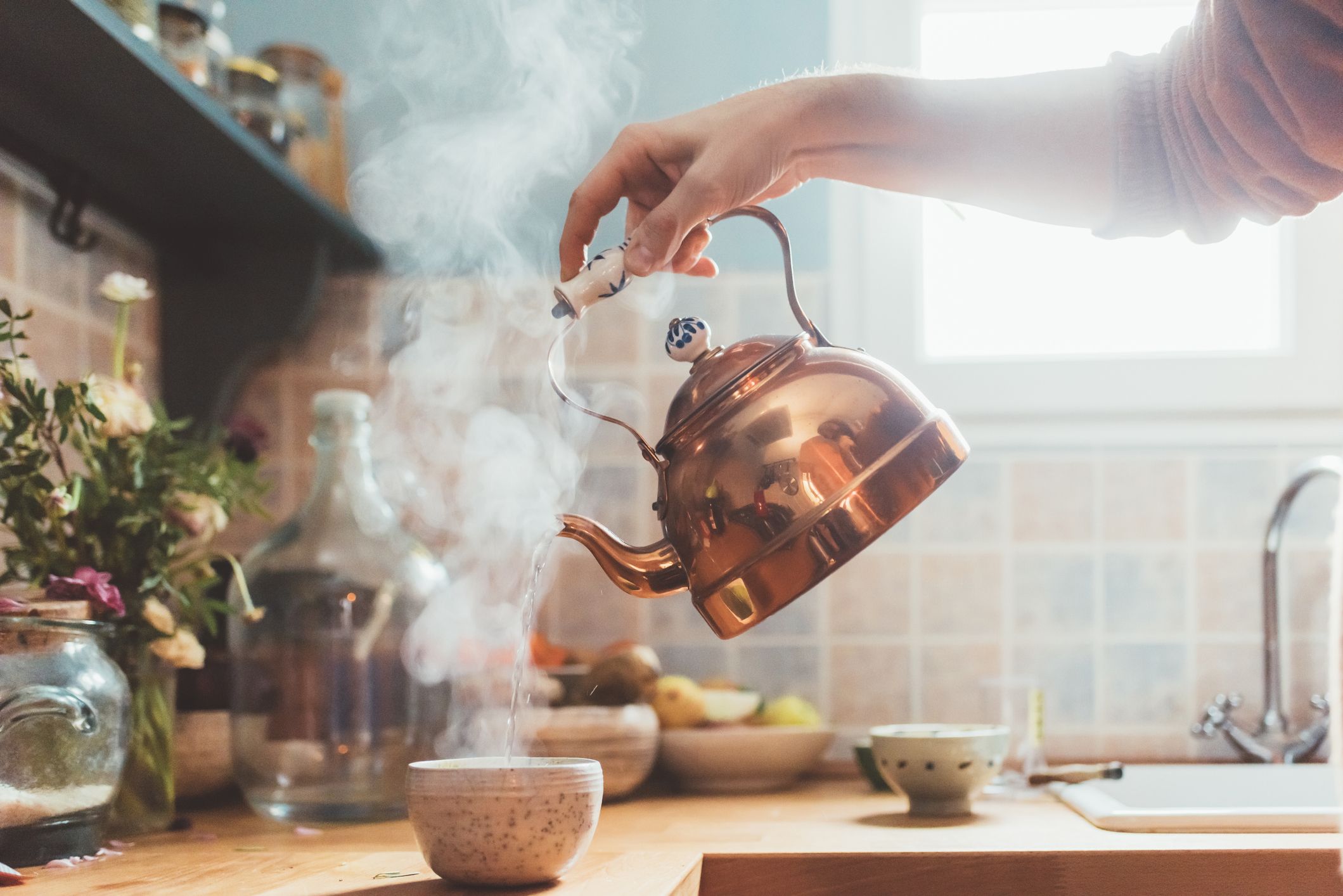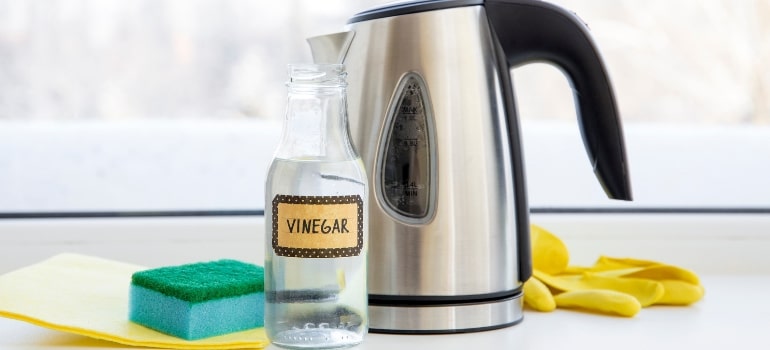Got a mineral buildup in your tea kettle? Tired of the off taste it adds to your cup of tea? Don’t worry, you can descale and remove the mineral buildup with a few simple steps.
In this article, you will learn how to clean your tea kettle quickly and get back to enjoying flavorful cups of tea!
Welcome to the complete guide of how to descale and remove mineral buildup from your tea kettle. In this helpful guide, we will provide you with the materials and directions you need to effectively descale your tea kettle and remove mineral deposits.
Hard water has minerals that build up on the surface of your tea kettle over time, making it difficult for water to move through the spout and causing it to take longer for water to boil. By properly descaling your kettle, you can restore its former performance in a safe and effective manner. Let’s get started!
Importance of descaling and removing mineral buildup from tea kettle
The buildup of scale in a tea kettle is not only unsightly, but it also can be hazardous to your health. This is because this mineral buildup can affect the taste of your tea and also make it difficult to bring the water to a boil. A descaled tea kettle will not only make your tea taste better but will also help reduce energy costs as it takes less energy to bring the water to a boil. Additionally, mineral buildup can act as an insulator and prevent your kettle from heating up quickly.
Descaling and removing mineral buildup from the interior of your tea kettle is an important part of maintaining its functioning and increasing its lifespan. Descalers like vinegar or citric acid used regularly can dissolve minerals from the interior surface of your kettle, making it easier for you to keep it clean and free of any residue or film. Additionally, regular cleaning will keep rust at bay and prevent bacteria from growing inside your pot.
Signs of mineral buildup in tea kettle
Being able to recognize the signs of mineral buildup in your tea kettle is the first step in being able to remove it. A kettle with calcium deposits will have a milky and cloudy appearance, as well as noticeable residue on the inside and bottom of the pot. You may also hear a faint rumbling noise or knocking sound when you are boiling water.
If any of these symptoms present themselves, it’s time to descale your tea pot.
Unpleasant taste and odor
The buildup of minerals from repeated boiling of water can cause an unpleasant taste or odor. These deposits, also known as scale, are caused by the minerals naturally present in your water supply. Over time, the scale can build up on the walls and bottom of your teapot or tea kettle and make it harder to clean. To get rid of this buildup and keep your teapot or kettle running smoothly, you should descale it regularly so that you can enjoy a better-tasting cup of tea.
Descaling involves using a mild acid such as white vinegar to dissolve these deposits. Descale as follows: Disconnect your appliance from the power before starting – Fill the pot with two parts white vinegar to one part water – Place the kettle on a burner over medium heat – Let it simmer for several minutes until all bits of scale have been dissolved.
Once finished, allow the mixture to cool before pouring out. Rinse with clean cold water several times until any odor is gone. Finally, dry completely and re-boil some fresh water before use. Regular descaling will ensure that your teapot or tea kettle remain in good condition and will give you that best cup of tea every time!
Discoloration of water or kettle
The discoloration of water or your kettle may be a sign of mineral buildup which is caused by calcium and magnesium deposits. Hard water contains more levels of these minerals, which over time accumulate and can cause staining, scaly build-up, and even block the spout or nozzle of your tea kettle. In order to ensure you experience an optimal cup of tea or coffee and keep your kettle in perfect working condition, it is important to descale the kettle regularly.
Here are some steps to follow for an effective descaling process:
Reduced efficiency of heating element
Descaling and removing mineral buildup from your tea kettle is essential for its optimal performance. It can help make sure that the boiling process runs efficiently and that your kettle saves you energy. Reduced efficiency of a heating element may indicate a build-up of minerals on the element, making descaling and mineral removal important.
There are several methods to do this:
– Boiling vinegar: fill the tea kettle halfway with white distilled vinegar, then fill it with water to the top. Boil the mixture in your tea kettle for five minutes, allow it to cool for two hours so the vinegar can soften any scale in the kettle’s spout or tube. Then empty it, rinse it several times with plain water to remove all traces of vinegar from the inside.
– Lemon juice and salt: fill your tea kettle halfway with equal parts lemon juice and water. Add a small handful of table salt to this mixture and bring it to a boil in your tea kettle. Let it boil for five minutes before allowing the mixture to cool down for two hours before discarding it and rinsing your device several times with plain water.
-Industrial descalers: these chemical products are specifically designed to remove buildup quickly, easily, safely and effectively from all types of kitchen devices, including kettles made of cast iron, stainless steel or aluminum used for domestic purposes or in bars, restaurants or other catering establishments where more amounts must be heated simultaneously. Follow instructions carefully when using commercial chemicals product as they may affect different surfaces in different ways – never use them on copper utensils as they will be irreparably oxidized..
III. Materials needed for descaling and cleaning
Descaling your tea kettle is essential in order to maintain and optimize your appliance’s performance. Here are the common materials you will need to effectively clean and descale your tea kettle:
- White vinegar
- Tea tree oil
- Soft sponge
- Small bowl or cup
- Soft cloth
- Baking soda (optional)
You may also want to wear gloves and eyewear for protection during the cleaning process if you feel it is necessary.
White vinegar or citric acid
White vinegar and citric acid are commonly used to descale and remove mineral buildup from tea kettles. White vinegar has a mild acidic property which works to dissolve hard water deposits. Citric acid is an effective descaling agent since it is very low in pH. It helps break down scale quickly when dissolved into hot water.
To descale with white vinegar, fill the kettle with equal parts of warm water and white vinegar, letting it sit for at least an hour or overnight. Before boiling the solution, throw out the solution and rinse the pot extensively with clean water.
To descale with citric acid, dissolve two tablespoons of citric acid in two cups of warm water inside the kettle and let sit for 15-20 minutes before pouring out. Rinse the pot thoroughly with cold water when you are done to ensure all remnants of citric acid are removed from your tea kettle.
Water
Water quality can drastically affect the flavor of your tea. Water that is hard, meaning it is full of minerals like calcium and magnesium, can build up in your kettle and cause an undesirably bitter taste. It’s very important to regularly descale any metal tea kettles you own to ensure maximum flavor from each cup of tea.
Descaling solutions break down mineral deposits and make them easier to remove. There are a variety of descaling agents available commercially, but a solution made up of equal parts white vinegar and water can also do the trick. Fill your kettle with 2 cups vinegar and 2 cups water, bring it to a boil then let it sit for an hour or two before cleaning it out with a soft sponge or cloth.
It may take several cycles with the vinegar-water solution before all deposits are completely removed from the inside or outside surface of your kettle – particularly if you’re dealing with hard water buildup along the inside edges – so be sure to keep an eye out for any remnants after each cycle. If any stubborn deposits remain, use a soft brush or clean cloth with some salt on it to scrub away remaining bits without damaging your kettle’s surface.
Soft brush or sponge
You will need a soft brush or sponge to gently remove the mineral deposits. Hard scrubbing will damage your tea kettle. Start by wiping down the outside of the kettle with a damp cloth to get rid of any dust or dirt. You can then submerge it in a mixture of warm water and a few drops of natural cleaner like vinegar or lemon juice, if desired.
Take the brush or sponge to the interior surface of the tea kettle in circular motions. Make sure to use gentle pressure while cleaning, as too much force can cause scratches that may eventually lead to rust buildup. If you’d like more intense cleaning, you can soak your tea kettle in vinegar overnight and rinse it out with cold water after removing it from the vinegar solution.
Gloves
When completing any descaling task, it is important to ensure that you are protecting your skin and clothes while also preventing any chemical accidents. Ideally, it is best to use kitchen gloves when dealing with cleaning solutions. Kitchen gloves can be found in most supermarkets and drug stores near the cleaning supplies and come in a variety of materials such as latex, rubber, nitrile, or plastic-coated materials for added strength and protection.
If you don’t have kitchen gloves or don’t want to buy new ones, then be sure you wear long sleeves with cuffs and long pants. Additionally, consider wearing a pair of rubber kitchen gloves underneath your clothes for extra protection. When all else fails, use something such as an old towel between your hands and the cleaning solution while still protecting your skin from direct contact.
Once finished, be sure to launder the clothes worn during this process separately from other clothing items due to potential damage caused by contact with descaling solutions.
Conclusion
By performing regular maintenance of your teakettle, you can prevent mineral buildup and keep it looking and working at its best. Descaling your teakettle should be done every few months (or sooner, depending on how hard your water is) to get rid of mineral deposits caused by hard water.
Using a combination of vinegar and citrus juice or a commercial descaling product is an easy and effective way to remove those pesky minerals from your tea kettle without any extra effort. Try out these methods for removing mineral buildup from your teakettle today and you’ll never have to worry about buying a new one again!
FAQ’s
How do I get rid of thick limescale in my kettle?
One common method is to fill the kettle with equal parts water and vinegar, bring it to a boil, let it cool, then rinse it thoroughly. Another option is to use a commercial descaler specifically designed for kettles.
How do you remove calcium deposits from an electric tea kettle?
The same method can be used as for removing limescale from a regular kettle, which is to fill it with a solution of water and vinegar and bring it to a boil. Then, let it cool down, rinse thoroughly, and repeat if necessary.
How do you Deoxidize a tea kettle?
To remove any oxidation from a tea kettle, you can make a paste of baking soda and water, apply it to the affected areas, let it sit for a few minutes, and then scrub it away with a non-abrasive sponge.
What is the best thing to use to descale a kettle?
The most common and effective method is to use a solution of equal parts water and vinegar, boiled in the kettle, and then rinsed thoroughly. Commercial descaling products specifically designed for kettles are also available.
What dissolves thick limescale?
Vinegar and lemon juice are both effective at dissolving limescale.
Does baking soda get rid of limescale in kettle?
Baking soda can help to remove limescale from a kettle, but it is not as effective as vinegar or commercial descaling products.
How do you get rid of mineral deposits?
Mineral deposits can be removed by soaking the affected area in a solution of vinegar and water or using a commercial descaler. Scrubbing with a non-abrasive sponge can also help.
How do you remove strong limescale?
A strong solution of vinegar and water can be effective in removing strong limescale. Let the solution sit in the kettle for a few hours before rinsing thoroughly.
Can you drink out of a kettle with limescale?
While limescale is not harmful to consume, it can affect the taste of the water. It is recommended to descale the kettle regularly for optimal performance and taste.
What is the thick white stuff in my kettle?
The thick white substance is likely limescale, a buildup of mineral deposits that occurs from boiling hard water in the kettle.
See Also-
- Best coffee kettle
- Best ceramic electric kettle
- Best gooseneck electric kettle
- Best gooseneck kettle
- Best tea kettle for glass cooktop

